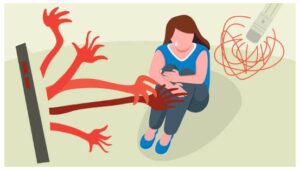Cognitive Behavioural Therapy for anxiety is one of the most widely used
therapies to treat anxiety disorders. Cognitive therapy assesses how negative
thoughts contribute to anxiety. Behavior therapy assesses how one behaves and
reacts in situations that trigger anxiety. The basic premise is that our thoughts
affect the way we feel. The goal of CBT for anxiety is to identify and correct these
negative thoughts and beliefs. That is if one changes the way one thinks, they can
change the way they feel.
Thought challenging in CBT for anxiety:
- Identify your negative thoughts
- Challenging your negative thoughts
- Replacing negative thoughts with realistic thoughts
Three simple techniques of Cognitive Behavioral Therapy for Anxiety:
- CBT Technique 1: This involves focusing on how the feelings will change.
- CBT Technique 2: Chew it over and act normal – For instance during
emergency situation calm yourself by:-
Talk softly and calmly
Smile
Salivate
Breathe deeply - CBT Technique 3: This involves catching the underlying assumption and chasing them.
Techniques of CBT for OCD (Obsessive Compulsive Disorder):
Obsessive-Compulsive Disorder is driven by anxiety and fueled by stress.
- Learn to not pay attention to that bully or call
- Learn lots of skills to help you deviate from those thoughts
- Learn mindfulness techniques to help learn to control your focus of attention
- Learn to change our behavior
- Expose yourself to that what makes you feel anxious and learn not to do the
compulsion to retain - Learn and use coping skills
The CBT diamond – Four interlinked processes taken into account for CBT for
social anxiety: All these are interconnected
Symptoms of bodily sensations in social anxiety:
Blushing
Dizziness
A fast heartbeat
Difficulty in breathing
Difficulty in swallowing
Trembling
Sweating
Nausea
A cracked voice
A need to cry
Difficulty in concentrating
Numbness or tingling in the body
Blurred vision
A feeling of derealization
Warmth sensations in your body and face
Dry mouth
Chest pain or a feeling of tightness in the chest muscles
Weakness in the body
Feelings:
Disappointed
Depressed
Shame
Isolation
Thoughts and behavior:
Thinking of oneself as dumb
Avoid social relationships
Not making new acquaintances
Socially incompetent
Feeling of panic
Avoid social gatherings and conversations
Thought of everyone thinking you as pathetic
Sadness
The aim of Cognitive Behavioral Therapy for anxiety is to break the destructive
chain process affecting your thoughts, feelings which in turn affect your behavior
and bodily sensations with targeted interventions.
Tackling anxieties:
- Learn about anxiety
- Cultivate your connections with other people
- Adopt healthy lifestyle habits
- Reduce stress in your life
How Cognitive Behavioral Therapy for anxiety works?
Problems are solved by breaking them down into parts as:-
- Situations
- Thoughts
- Emotions
- Physical Feelings
- Actions
- It is more pragmatic.
- Highly structured.
- Focused on current problems.
- It aims to stop the negative cycle of thoughts.
- CBT can help you to get to a point where you can tackle problems without a
therapist. - Exposure therapy, which is a form of CBT helpful for treating phobias and
OCD. - CBT sessions which would include:-
- Questioning upsetting thoughts and replacing them with more helpful
ones. - Recognizing when you are going to do something that will make you
feel worse and instead of doing something more helpful. - Confronting your fears and anxieties.
- Online CBT sessions with therapists are equally useful as a number of
interactive tools are available now.
- Questioning upsetting thoughts and replacing them with more helpful
Feel free to reach out to us for counseling and psychotherapy sessions from our trained psychologists, and psychotherapists.




